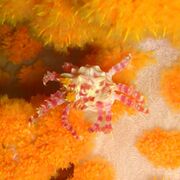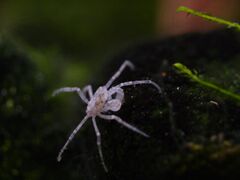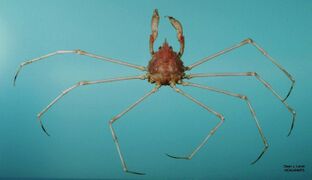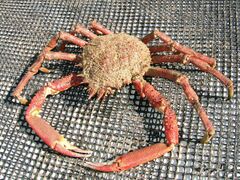Biology:Majoidea
From HandWiki
Short description: Superfamily of crabs
| Majoidea | |
|---|---|
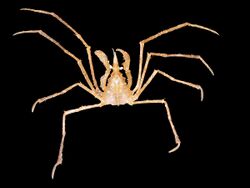
| |
| Macropodia rostrata (Inachidae) | |
| Scientific classification | |
| Domain: | Eukaryota |
| Kingdom: | Animalia |
| Phylum: | Arthropoda |
| Class: | Malacostraca |
| Order: | Decapoda |
| Suborder: | Pleocyemata |
| Infraorder: | Brachyura |
| Subsection: | Heterotremata |
| Superfamily: | Majoidea Samouelle, 1819 |
The Majoidea are a superfamily of crabs which includes the various spider crabs.
Taxonomy
In "A classification of living and fossil genera of decapod crustaceans" De Grave and colleagues divided Majoidea into six families:[1]
- Family Epialtidae
- Subfamily Epialtinae
- Subfamily Pisinae
- Subfamily Pliosomatinae
- Subfamily Tychiinae
- Family Hymenosomatidae
- Family Inachidae
- Family Inachoididae
- Family Majidae
- Subfamily Eurynolambrinae
- Subfamily Majinae
- Subfamily Micromaiinae
- Subfamily Mithracinae
- Subfamily Planoterginae
- Family Oregoniidae
The classification has since been revised, with subfamilies Epialtinae and Mithracinae being elevated to families and Hymenosomatidae being moved to its own superfamily. The family composition according to the World Register of Marine Species is as follows:[2]
- family Epialtidae MacLeay, 1838
- family Inachidae MacLeay, 1838
- family Inachoididae Dana, 1851
- family Macrocheiridae Dana, 1851
- family Majidae Samouelle, 1819 – "true" spider crabs
- family Mithracidae Balss, 1929
- family Oregoniidae Garth, 1958
- family †Priscinachidae Breton, 2009
Notable species within the superfamily include:
- Japanese spider crab (Macrocheira kaempferi), the largest living species of crab, found on the bottom of the Pacific Ocean.
- Libinia emarginata, the portly spider crab, a species of crab found in estuarine habitats on the east coast of North America.
- Hyas, a genus of spider crabs, including the great spider crab (Hyas araneus), found in the Atlantic and the North Sea.
- Maja squinado, sometimes called the "European long leg crab or pie faced crab" because of the way its face is shaped.
- Australian majid spider crab, found off Tasmania, are known to pile up on each other, the faster-moving crabs clambering over the smaller, slower ones.[3]
There is one fossil family, Priscinachidae, represented by a single species, Priscinachus elongatus, from the Cenomanian of France.[4]
Hoplophrys oatesi, an Epialtidae
References
- ↑ Sammy De Grave et al. (2009). "A classification of living and fossil genera of decapod crustaceans". Raffles Bulletin of Zoology Suppl. 21: 1–109. Archived from the original on 2011-06-06. https://web.archive.org/web/20110606064728/http://rmbr.nus.edu.sg/rbz/biblio/s21/s21rbz1-109.pdf.
- ↑ WoRMS. "Majoidea Samouelle, 1819". http://www.marinespecies.org/aphia.php?p=taxdetails&id=106700.
- ↑ Martha Holmes & Michael Gunton (2009). Life: Extraordinary Animals, Extreme Behaviour. London: BBC Books. ISBN:9781846076428.
- ↑ Gérard Breton (1 September 2009). "Description of Priscinachus elongatus n. gen., n. sp., and Priscinachidae n. fam. for the earliest spider crab (Crustacea, Decapoda, Majoidea), from the French Cretaceous (Cenomanian)" (in fr,en). Geodiversitas 31 (3): 509–523. doi:10.5252/g2009n3a2. https://sciencepress.mnhn.fr/sites/default/files/articles/pdf/g2009n3a2.pdf.
Wikidata ☰ Q280949 entry
 |
